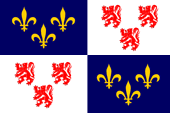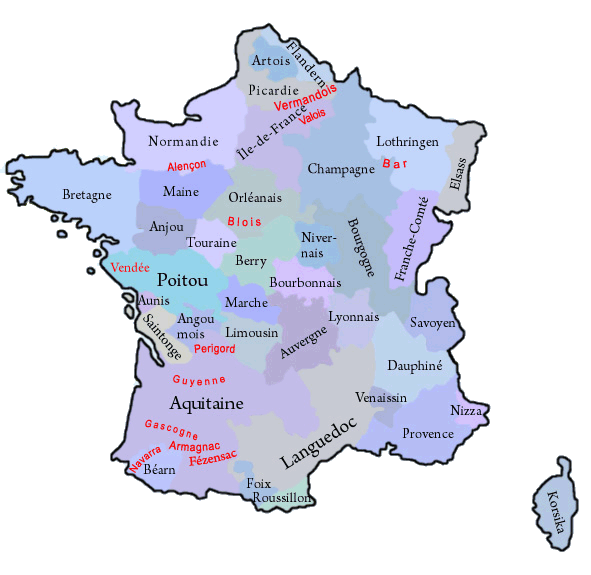mobile View, to the German Version tap the flag


- historical region in today's France
- former county and province
• Flag
• Meaning/Origin of the Flag
• Coat of Arms
• Meaning/Origin of the Coat of Arms
• Map of the historical Regions in France
• Explanations about the Regions
• Numbers and Facts
• History
• Origin of the Country's Name

Flag of Picardy
- Drapeau de Picardie,
Source, by: Wikipedia (DE)
1960–2016,
Unofficial flag of the Region of Picardie
– Drapeau de officieux de la Region Picardie
Source, by: Wikipedia (DE)






The historic flag of Picardy was a scutcheon-flag. It showed the image of the historic coat of arms. The between the years 1960 and 2016 existing Region of "Picardy" used that model as an unofficial flag.
Source:
Volker Preuß,
Wikipedia (D)


Coat of arms of the Picardy
– Blason de Picardie,
Source, by:
Wikipedia (D)

The coat of arms of Picardy should have its roots in the year 1670, when that coat of arms had beed fixed in the university of Paris as coat of arms of the "Picardy Nation".
Source:
Wikipedia (FR),
Volker Preuß

The historical, French Regions:

in black: governorate and province in 1776,
in red: former county, province oder governorate
Map: Volker Preuß

The until the French Revolution existing provinces (or governorates) have been historically grown structures, which had their roots oftenly in former fiefdoms of the French crown, historic counties and duchies. They oftenly existed for hundreds of years and had preserved regionality (e.g. cultural particularities and regional languages). On the occasion of the French Revolution such phenomena were of course not desirable, and as part of their bloody and violent egalitarianism any regional references were eliminated. Shortly after the French Revolution the provinces were dissolved and France became divided into many départements, which should have approximately the same size and the same status. The départements were named after rivers or mountains, to use never and in no circumstances the name of an old province. However, there was no success in cutting the connections of the people of France to their respective regions, so that administrative regions were re-created in 1960, to have a better control in regional administrative processes. In this way became départements, which were placed in a historical province, administratively grouped to an oftenly historically named region. The resulted structures coincide only approximately with the boundaries of the old provinces. In the strictly centralist France any regionality is avoided, so that even the official flags of these regions mostly look like flags of companies, unloving, unhistorical, technocratic and modernistic, and these flags should not be a subject of any lexical considerations here. Only in a few of that regions, exist official flags which remember the historical models. But, even the existence of these today's regions is douptful, because in 2014 was passed a territorial reform valid from the year 2016, that reduces the number of the existing regions by merging to nearly the half. However, there exist unofficial flags in nearly all of these regions, which should remember the old provinces and the old heraldry.
Wikipedia Link to the regions of France:
click or tap here
FOTW Link to the regions of France:
click or tap here
Source: Flags of the World,
Wikipedia (D),
Volker Preuß

The Picardy region was larger than the historical province, which covered only the northern part of the region.
The region (1960-2016):
Area: 7.490 sq.mi.
Inhabitants: 1.931.131 (2018)
Density of Population: 258 inh./sq.mi.
Capital: Amiens, 133.891 inh. (2018)
Languages: French, Picard
Time Zone: GMT + 1h
Source: Wikipedia (D)

antiquity · settlement by the Celtic tribes of the Ambians and the Viromanduans
55 B.C. · Roman conquest
5th century A.D. · conquest and settlement by the Franks
481–863 · to the Frankish Empire, Amiens is temporarily capital of the Frankish Empire, establish of the County of Ponthieu
880 · Treaty of Verdun and Ribbemont, at the division of the Frankish Empire comes the Picardy (incl. Ponthieu) to the West Frankish Kingdom (France)
1167 · Philip of Alsace, Count of Flanders, acquires by marriage the County of Picardy, it comes after the extinction of his successors back to France
1419/1435 · Hundred Years' War, France against England and Burgundy, the Picardy comes to Burgundy
1477 · death of Charles the Bold, Duke of Burgundy, in the following years succession disputes
1493 · Peace of Senlis, Picardy (and Burgundy) come to France, the Picardy later became a governorate (province) of the Kingdom of France
1776 · the already in the 14th century created governorates of the civil administration of the kingdom of France become committed to a number of 39, and correspond in this way to the number of provinces, in previous years could any provinces be summarized in one governorate
1789 · French Revolution, the governorates become abolished, the Picardy is broken down into some départements
1960 · reintroduction of regions in France, formation of the Picardy Region, but not within the historic boundaries, just by integrating of the Departements of Oise, Somme and Aisne
2016 · the Nord-Pas-de-Calais and Picardy regions merge in the new, larger region of Hauts-de-France ('Heights of France', capital: Lille)
Source:
Meyers Konversationslexikon,
Wikipedia (D),
Taschenatlas Weltgeschichte

The name of the Country "Picardy" goes back to a weapon of the Middle Ages, the "Pike". In this area, especially pikemen were recruited as mercenaries at that time.
Source:
Handbuch der geographischen Namen


![]()






